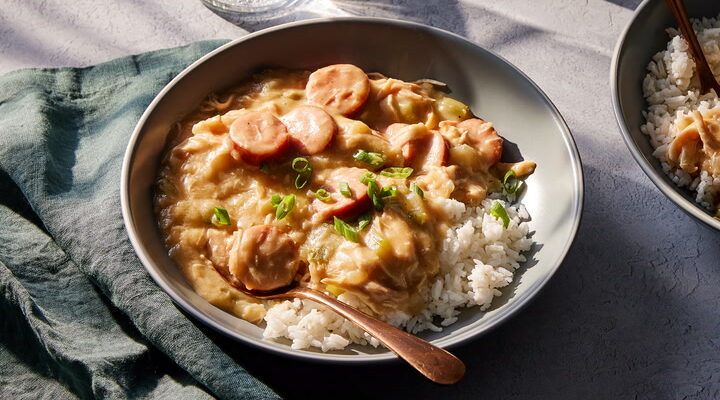Easy Gumbo Recipe: Gumbo is more than just a dish—it’s a celebration of Southern soul and culture wrapped in a rich, savory stew. Hailing from Louisiana, gumbo represents a melting pot of cultures—African, French, Spanish, and Native American. Every bite tells a story of history, tradition, and community. It’s warm, hearty, and full of flavor, making it a favorite comfort food across the Southern United States and beyond.
But what really defines gumbo? It’s that dark, rich base called roux, combined with bold spices, meats, and the essential “Holy Trinity” of vegetables—onion, celery, and bell pepper. Whether you love it packed with shrimp and crab, or loaded with smoked sausage and chicken, gumbo has a version for everyone. The beauty of this dish is its flexibility and the ability to make it your own. And the best part? You don’t need to be from New Orleans to make it like a pro.
Key Ingredients for an Authentic Gumbo
Crafting the perfect gumbo starts with gathering the right ingredients. These aren’t just random items you toss together—they’re the building blocks of flavor that create gumbo’s signature taste.
Protein Choices – Chicken, Sausage, and Seafood
Gumbo typically starts with a hearty mix of proteins. Chicken thighs or drumsticks are popular because they hold up well during slow cooking and absorb flavor beautifully. Add some Andouille sausage for that spicy, smoky punch—it’s a total game-changer. If you’re a seafood lover, go wild with shrimp, crab, or even crawfish. Pro tip: cook your seafood separately and add it at the end to keep it tender and juicy.
The Holy Trinity – Onion, Bell Pepper, and Celery
You can’t make gumbo without the Holy Trinity—onion, bell pepper, and celery. This flavor trio forms the backbone of the dish, infusing it with depth and aroma. Dice them fine so they melt into the roux and create that rich, veggie-infused base. It’s a Southern thing, and once you try it, you’ll never skip it.
Roux – The Heart of Gumbo
Ah, the roux. It’s where everything begins. A roux is simply flour and fat (usually oil or butter) cooked together until it reaches a deep brown color. The darker the roux, the richer the flavor. It takes patience—don’t rush it. Stir constantly and don’t let it burn, or you’ll have to start all over. A good roux gives gumbo its nutty, almost chocolatey foundation and thickens the stew to perfection.
Tools You’ll Need
Before you dive into making gumbo, make sure your kitchen is equipped with the right tools. Having the proper equipment will make your cooking experience smoother and way more enjoyable.
Best Pots and Utensils for Gumbo
A large, heavy-bottomed stock pot is essential. You’ll want something that distributes heat evenly to avoid burning your roux. A Dutch oven works wonders if you have one. You’ll also need a sturdy whisk or wooden spoon for stirring the roux, a ladle for serving, and a sharp knife for prepping all those veggies and proteins. Trust me, having the right tools makes all the difference when you’re tackling a rich, layered dish like gumbo.
Step-by-Step Gumbo Recipe
Let’s get into the heart of the matter. Here’s a super easy, step-by-step guide to making a mouthwatering gumbo that’ll impress everyone—whether it’s your first time or your fiftieth.
Step 1: Making the Roux
Start by heating ½ cup of vegetable oil in your pot over medium heat. Slowly whisk in ½ cup of all-purpose flour. Now here’s where patience is key—keep whisking continuously for about 20-30 minutes. You’re looking for a deep brown, almost chocolate color. It should smell nutty and slightly toasty. This is the soul of your gumbo, so don’t cut corners here. If it burns, toss it and start again.
Step 2: Cooking the Holy Trinity
Once your roux is perfect, toss in 1 cup each of diced onion, green bell pepper, and celery. Stir them into the roux and cook for about 5-7 minutes until they’re soft and fragrant. This is when the kitchen really starts to smell amazing. The veggies will break down and meld with the roux, forming that magical base that makes gumbo so irresistible.
Step 3: Adding the Protein
Add your chopped Andouille sausage and cook for 5 minutes to let the flavors develop. Then add your chicken (boneless thighs or drumsticks work best) and brown it lightly. Pour in about 6 cups of chicken stock, bring it to a simmer, and let it cook uncovered for at least 45 minutes. If you’re using seafood, wait until the last 10 minutes of cooking to add it—shrimp and crab don’t take long.
Step 4: Seasoning and Simmering
Now that the proteins are simmering and releasing their delicious juices into the pot, it’s time to season like a true Cajun chef. Add 2 teaspoons of Cajun or Creole seasoning, 1 teaspoon of thyme, a couple of bay leaves, and salt and black pepper to taste. Want a little heat? Toss in some cayenne pepper or a splash of hot sauce. The flavors should be bold but balanced. Don’t forget to taste and adjust as it simmers—this dish is all about building flavor slowly.
Let your gumbo bubble away for another 30 minutes, uncovered. The broth will thicken slightly thanks to the roux, and all the ingredients will come together beautifully. If you’re going with seafood, now’s the time to gently stir in shrimp, crabmeat, or crawfish tails. Let them cook just until they’re opaque and tender—usually 5-7 minutes tops.
Step 5: Serving Gumbo the Right Way
When your gumbo is done, remove the bay leaves and give everything one final stir. Now here comes the classic Southern way to serve it—over a scoop of fluffy white rice. Ladle your gumbo into bowls, spoon the rice in the center, and sprinkle some chopped green onions or parsley on top for freshness. A few dashes of hot sauce don’t hurt either.
Serve with a slice of crusty French bread or cornbread on the side, and you’ve got a meal that’s comforting, flavorful, and satisfying down to the last bite.
Pro Tips for the Best Gumbo
Want to take your gumbo from good to unforgettable? Here are some insider tips:
- Use dark roux: The darker, the better—just don’t burn it.
- Don’t skip the trinity: This veggie mix is the heart of gumbo.
- Layer your flavors: Sear your meat, simmer your broth, and taste as you go.
- Add filé powder or okra for extra thickness: Filé (ground sassafras leaves) gives a unique flavor and silky texture.
- Let it rest: Gumbo tastes even better the next day, after all the flavors have had time to deepen.
Common Gumbo Mistakes to Avoid
Even seasoned cooks can mess up gumbo if they’re not careful. Here’s what not to do:
- Rushing the roux: If it’s too light or burnt, your gumbo will suffer.
- Overcooking seafood: Nobody wants rubbery shrimp—add them last!
- Skipping the simmer: This dish needs time to develop those bold flavors.
- Using raw sausage: Always brown sausage first to get that smoky depth.
- Over-seasoning too early: Flavors intensify as it cooks, so taste before adding more.
How to Store and Reheat Gumbo
Gumbo makes fantastic leftovers. In fact, it’s often better the next day. Store it in an airtight container in the fridge for up to 4 days. For longer storage, freeze portions in zip-top bags or containers for up to 3 months.
To reheat, gently warm it on the stovetop over medium heat until hot. If it’s too thick, add a splash of broth or water to loosen it up. Microwave works in a pinch—just heat it in 1-minute intervals, stirring in between.
Gumbo Variations You Should Try
While traditional gumbo is unbeatable, there are a few variations that deserve a spot on your dinner table:
- Seafood Gumbo: Load it with shrimp, crab, oysters, and okra.
- Chicken and Sausage Gumbo: A smoky, hearty classic.
- Duck Gumbo: Rich and gamey, often made with wild duck and spicy sausage.
- Vegetarian Gumbo: Skip the meat and go all-in with mushrooms, okra, and beans.
- Gumbo Z’Herbes: A green gumbo packed with leafy greens—perfect for Lent or Meatless Mondays.
FAQs about Easy Gumbo Recipe
1. What is gumbo?
Gumbo is a hearty Louisiana stew that blends Creole and Cajun flavors. It typically includes a flavorful roux, vegetables (called the “holy trinity” – onion, celery, and bell pepper), meat or seafood, and is served over rice.
2. What’s the difference between gumbo and jambalaya?
Gumbo is a stew served over rice, while jambalaya is a rice dish cooked with the meat, seafood, and vegetables mixed in. Gumbo uses a roux for thickening, whereas jambalaya doesn’t.
3. Do I need to use okra in gumbo?
Okra is traditional and helps thicken the gumbo, but it’s optional. You can also use file powder (ground sassafras leaves) or just rely on the roux for thickening.
4. Can I make gumbo without a roux?
Yes, but the roux adds depth and richness. For a lighter version, you can skip it or substitute with cornstarch, but the flavor may be different.
5. What meats go best in gumbo?
Smoked sausage (like andouille), chicken, shrimp, crab, and crawfish are popular. You can mix and match based on taste and availability.
6. How long does gumbo last in the fridge?
Gumbo stays fresh for up to 3–4 days in the refrigerator. The flavor often improves after a day, making leftovers even better.
7. Can I freeze gumbo?
Absolutely! Gumbo freezes well for up to 3 months. Just cool it completely and store it in airtight containers.
8. How do I reheat gumbo?
Reheat gumbo on the stovetop over medium heat, stirring occasionally. You can also use the microwave, but stir well to heat evenly.
9. Is gumbo spicy?
Gumbo can be mildly spiced or fiery, depending on your preference. Adjust the heat with cayenne pepper or hot sauce.
10. What should I serve with gumbo?
Traditionally, gumbo is served over white rice. It also pairs well with cornbread, potato salad, or crusty French bread.
Final Thoughts
Gumbo is more than a meal—it’s an experience. Every step in the process, from whisking the roux to ladling the final bowl, connects you to centuries of Southern tradition. Whether you’re new to Cajun cuisine or looking to perfect your recipe, gumbo offers a delicious way to experiment, share, and savor the flavors of the South. So grab a spoon, gather your ingredients, and make your kitchen smell like New Orleans. You’ll be glad you did.



